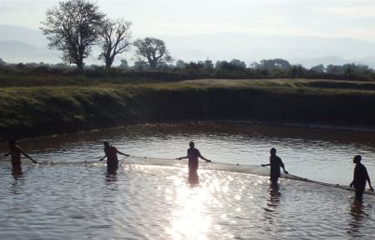IDH, the Sustainable Trade Initiative, is a public-private partnership convener that has a history of driving sustainability initiatives in the seafood sector, including partnering with WWF to establish the Aquaculture Stewardship Council (ASC) in 2010. It also organized and continues to operate a program in China’s Hainan province to improve tilapia farmers’ incomes and make the sector more attractive to investors and insurers, in part by transferring knowledge and technology to farmers.
The IDH Aquaculture Program dates back to 2009, and more recently, the group created the IDH Aquaculture Working Group on Environmental Footprint, an initiative to investigate the environmental footprint of aquaculture globally. The initiative now includes Tesco, Thai Union, Wegmans, Hilton Seafood, and Marks and Spencer, among others.
“Currently, we lack data on the environmental footprint of aquaculture of the whole value chain, especially on aquafeed. It is imperative that we understand the footprint of aquaculture products in terms of carbon footprint, water use, water quality, biodiversity, antibiotic use, and plastic use,” the group’s mission statement reads. “Producers that are currently performing well environmentally are currently not rewarded for doing so. The environmental impact between aquaculture species, culture systems, and geographical regions differ considerably. Given the vast diversity of the sector, it is better to have individual investigations instead of relying of averages for the industry that might not represent individual producers. If we better measure, we can distinguish products and producers that have a low environmental footprint from products and producers that have a higher environmental footprint. By better measuring, we can also identify hotspots along the supply chain where the negative environmental impacts are highest, and we can start improving the environmental footprint of aquaculture where needed.”
In a panel presented at the 2022 Seafood Expo Global in Barcelona, Spain on 26 April, “How to Measure and Reduce Carbon Emissions in Tropical Aquaculture – Lessons Learned from the IDH Aquaculture Working Group on Environmental Footprint,” IDH partners described their joint efforts to develop a methodology to quantify the greenhouse gas emissions, water use, and eutrophication generated from commercial aquaculture, and the benefits arising from collaborative data-collection efforts now underway amongst the “coalition of the willing” working on the effort.
Bjorn Kok, a data and methodology specialist at Gouda, The Netherlands-based Blonk Sustainability Tools, said existing aquaculture standards, such as the European Union’s Product Environment Category Rules, often require data reporting and set a framework for measuring carbon emissions.
Hilton Seafood, part of the Huntingdon, United Kingdom-based Hilton Food Group, has been gathering data from its seafood suppliers to allow it set “science-based targets” on reducing the firm’s carbon footprint. Joining the IDH group allowed it to see how other firms are setting impact-reduction targets for themselves through data collection, Hilton Seafood Aquaculture and Fisheries Manager Teresa Fernandez said.
Hilton Seafood sources many of its tropical products, including shrimp, from Asia, and many of its suppliers are already certified to various sustainability certifications that require data on inputs, so most have been very cooperative in supplying data, according to Fernandez.
“We tell them, ‘We need this data to work with retailers,’ and they are fine with supplying the data,” she said.
Dominique Gautier, director of sustainability at the Redditch, Worcestershire, U.K.-based Seafresh Group – a member of the IDH Aquaculture Working Group on Environmental Footprint – said the collection of better data is allowing companies to pressure suppliers of aquafeed to improve the sustainability of their sourcing.
Seafresh, which controls aquaculture operations growing king prawns in both Central America and Asia for processing and sales in North America, Europe, and Asia, has sought data on carbon emissions in inputs and outputs from three of its ASC-certified farms. That data, Gautier said, revealed that feed – and land-grown feed in particular – accounts for 70 percent of emissions.
“It’s the most-challenging area,” Gautier said.
The carbon emissions involved in land use changes make feeds like soy a big factor in high carbon emissions from aquaculture, he said. Gautier said he expects demands for better data will focus seafood-industry efforts on reducing inputs of soy from deforested areas.
But there are limits to how much leverage aquaculture can put on producers of soy given that aquafeed accounts for 6 percent of soy output, a much lower figure that that going to ruminant animals, Gautier said.
While environmental campaigners have claimed that industrial fishing for fishmeal inputs depletes oceans, endangers food security, and threatens wildlife, the fishmeal industry counters that the carbon footprint of land-grown feed ingredients is also high. Petter Johnansen, director general of the fishmeal and fish oil industry umbrella group IFFO, cited research, including “The Sustainability Conundrum of Fishmeal Substitution by Plant Ingredients in Shrimp Feeds,” from the University of Stirling, that found land-based aquafeed ingredients may not be a better solution than traditional fishmeal ingredients such as anchovy.
“Recent studies have shown that the use of plant resources worsens the environmental footprint of aquaculture more than if we had stayed with the use of marine ingredients,” he said in an interview with SeafoodSource. “The sustainability of feeding animals on food-grade plant resources like soybean protein and rapeseed oil has also been questioned.”
The IDH Aquaculture Working Group on Environmental Footprint has not yet crafted guidelines or suggestions for methods the aquaculture sector can take to reduce its carbon footprint, and has not yet identified how it will use the data it is collecting to push for lower emissions.
While stressing that Hilton and the working group are still studying the data thus far collected, Fernandez said the collaborative approach being taken by IDH will spark “friendly competition” where seafood firms seek to emulate and keep up with each other on actions to reduce emissions.
Photo courtesy of IDH, the Sustainable Trade Initiative







